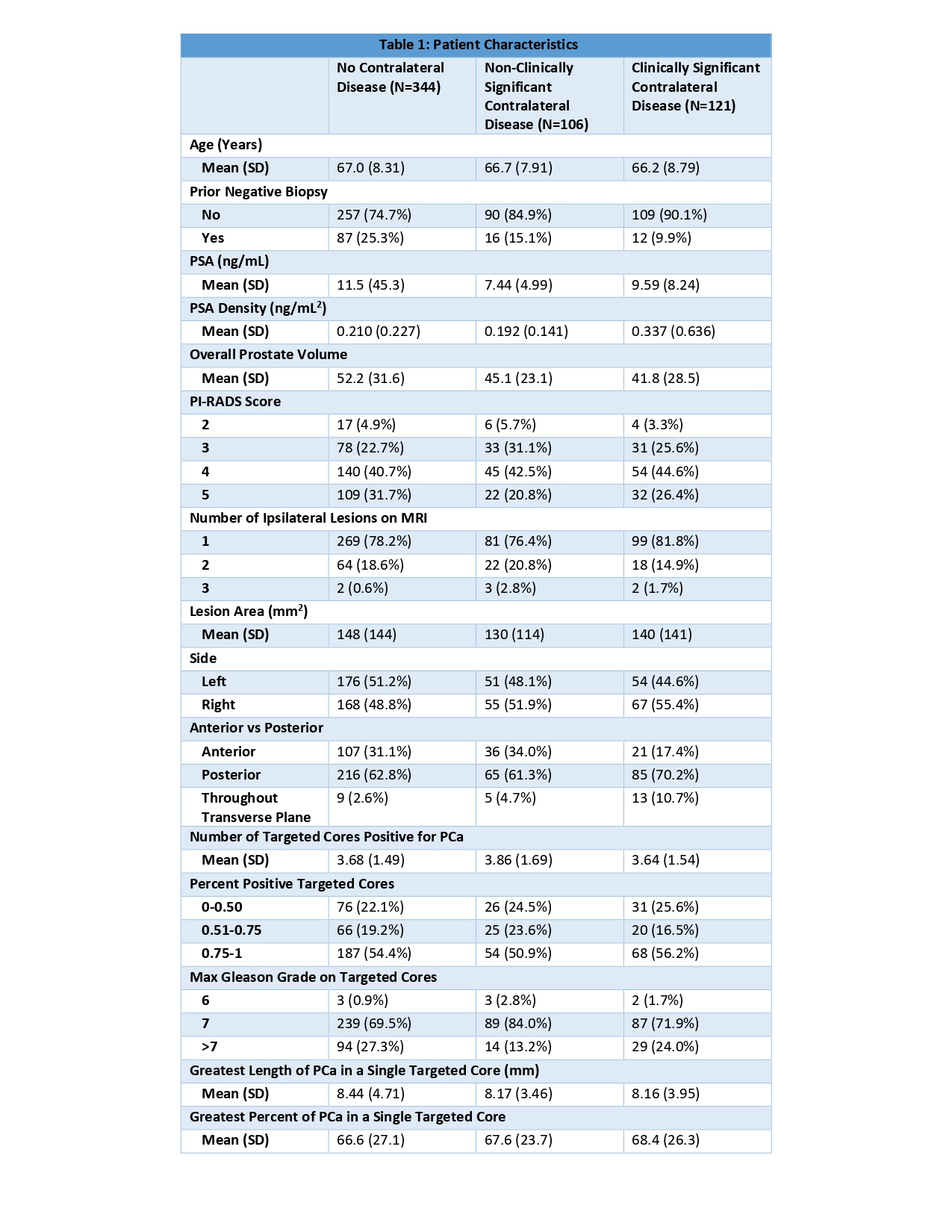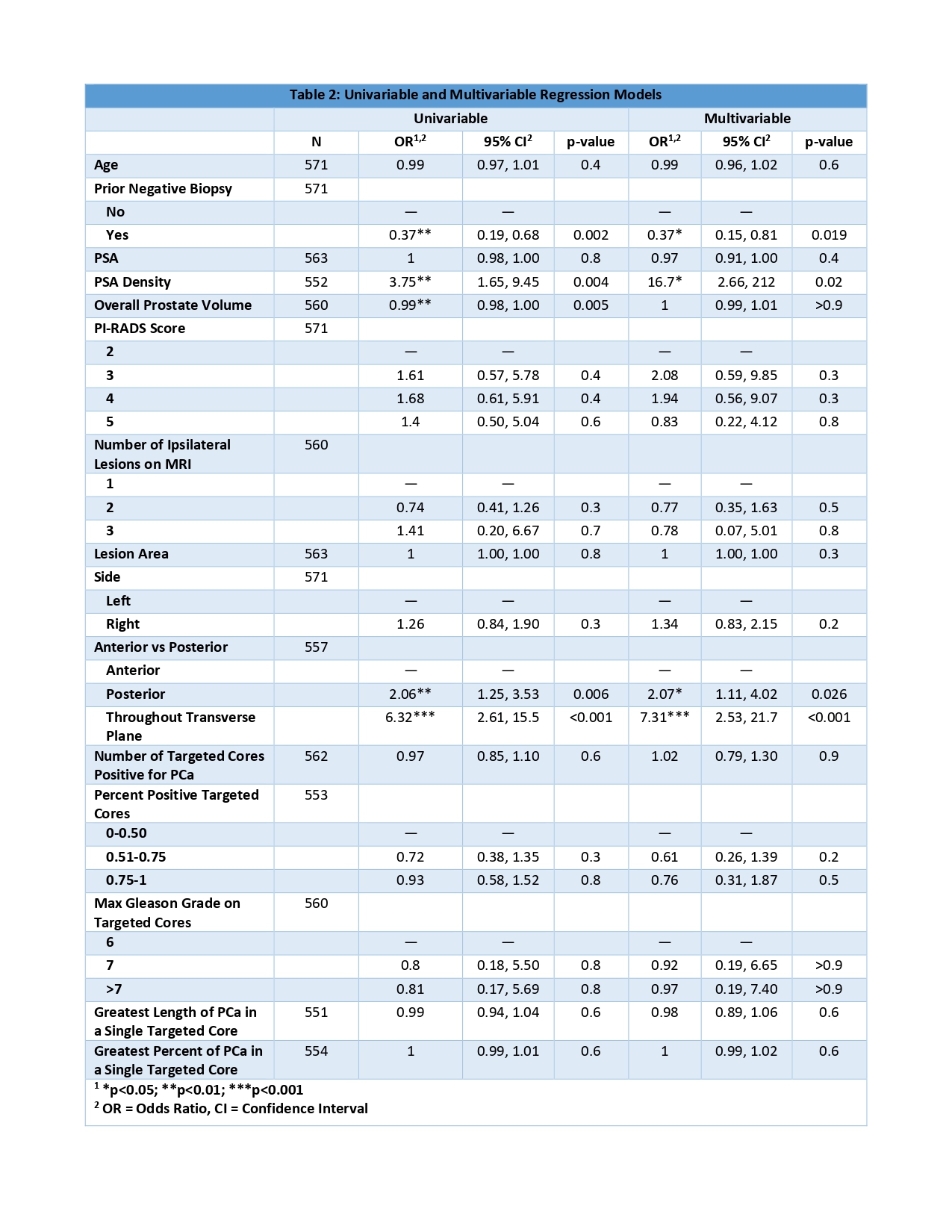Back
Poster, Podium & Video Sessions
Podium
PD57: Prostate Cancer: Detection & Screening VI
PD57-03: Predictors of Contralateral Disease in Men with Unilateral Lesions on Multiparametric MRI
Monday, May 16, 2022
9:50 AM – 10:00 AM
Location: Room 245
Vyom Sawhney*, Richard Huang, William C. Huang, Herbert Lepor, Samir S. Taneja, James Wysock, New York, NY
- VS
Podium Presenter(s)
Introduction: Ideal candidates for prostate ablation are those with unilateral, MRI-visible, clinically significant prostate cancer (csPCa). The possibility of contralateral csPCa has upheld the practice of performing a standard systematic biopsy (SB) in addition to a targeted-biopsy. This study evaluates predictors of contralateral csPCa in men with biopsy-proven, unilateral lesions on MRI.
Methods: We retrospectively identified men with no prior diagnosis of PCa with unilateral, biopsy-confirmed csPCa PI-RADS 2-5 lesions within our institutional biopsy database. Multivariable logistic regression was used to identify clinical predictors of contralateral disease.
Results: 571 men met study inclusion criteria. 227 men (39.8%) had contralateral PCa and 121 men (21.2%) had contralateral csPCa (Table 1).
Prior negative biopsy, prostate-specific antigen (PSA) density, overall prostate volume, and tumor location in the transverse plane were significantly associated with contralateral csPCa in univariable logistic regression models. Prior negative biopsy (OR 0.37 [0.15, 0.81], p = 0.019), PSA density (OR 16.7 [2.66, 212], p = 0.02), and tumor location in the transverse plane (Posterior: OR 2.07 [1.11, 4.02], p =0.026; Throughout Transverse Plane: OR 7.31 [2.53, 21.7], p <0.001) were also significantly associated with contralateral csPCa in a multivariable logistic regression model. However, there appear to be no attributes within the MRI-targeted tumor that reliably predict contralateral csPCa (Table 2).
Conclusions: Approximately 20% of men with unilateral MRI findings and csPCa on targeted-biopsy were found to have contralateral csPCa. Prior negative biopsy was associated with a significantly decreased odds of contralateral csPCa. PSA density and tumor in the posterior aspect of or throughout the transverse plane were associated with significantly increased odds of contralateral csPCa. Consideration of these clinical factors may afford an opportunity to only use SB in cases in which the odds of contralateral csPCa are high.
Source of Funding: The Joseph and Diane Steinberg Charitable Trust


Methods: We retrospectively identified men with no prior diagnosis of PCa with unilateral, biopsy-confirmed csPCa PI-RADS 2-5 lesions within our institutional biopsy database. Multivariable logistic regression was used to identify clinical predictors of contralateral disease.
Results: 571 men met study inclusion criteria. 227 men (39.8%) had contralateral PCa and 121 men (21.2%) had contralateral csPCa (Table 1).
Prior negative biopsy, prostate-specific antigen (PSA) density, overall prostate volume, and tumor location in the transverse plane were significantly associated with contralateral csPCa in univariable logistic regression models. Prior negative biopsy (OR 0.37 [0.15, 0.81], p = 0.019), PSA density (OR 16.7 [2.66, 212], p = 0.02), and tumor location in the transverse plane (Posterior: OR 2.07 [1.11, 4.02], p =0.026; Throughout Transverse Plane: OR 7.31 [2.53, 21.7], p <0.001) were also significantly associated with contralateral csPCa in a multivariable logistic regression model. However, there appear to be no attributes within the MRI-targeted tumor that reliably predict contralateral csPCa (Table 2).
Conclusions: Approximately 20% of men with unilateral MRI findings and csPCa on targeted-biopsy were found to have contralateral csPCa. Prior negative biopsy was associated with a significantly decreased odds of contralateral csPCa. PSA density and tumor in the posterior aspect of or throughout the transverse plane were associated with significantly increased odds of contralateral csPCa. Consideration of these clinical factors may afford an opportunity to only use SB in cases in which the odds of contralateral csPCa are high.
Source of Funding: The Joseph and Diane Steinberg Charitable Trust



.jpg)
.jpg)